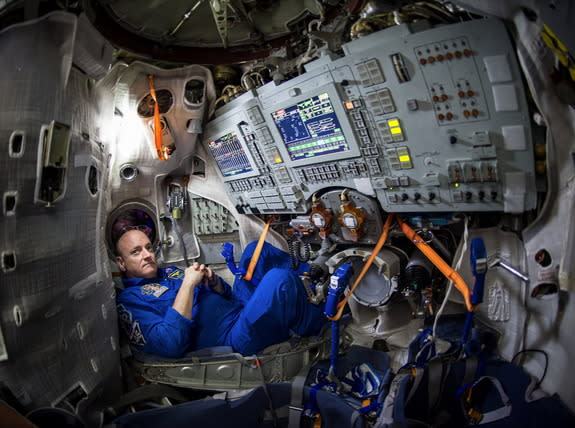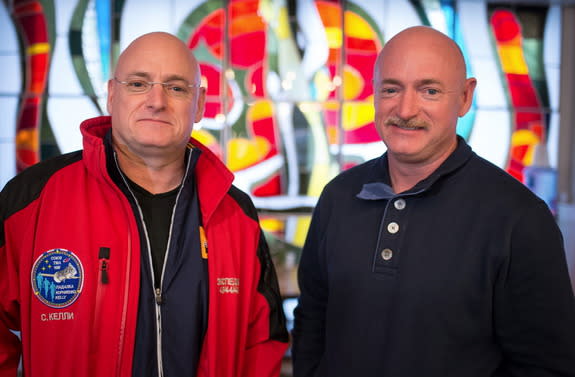Space Twins: Genetic Science Meets Space Travel on One-Year Mission
Does spaceflight affect the human body all the way down to the genetic level? And if so, can a study of those changes help protect or even select future astronauts? Scientists working on NASA's one-year mission are taking the first steps toward answering those questions.
Astronaut Scott Kelly and cosmonaut Mikhail Kornienko are living on the International Space Station for just shy of one Earth year. While they aren't the first people to live in space for that long, they are under far more scientific scrutiny than any of those to come before them. NASA has emphasized that the goal of the mission is to prepare humans for the long journey to Mars.
Kelly is offering genetic scientists a particularly interesting variable to study: He has an identical twin brother, former NASA astronaut Mark Kelly, living on the ground and undergoing the same swath of tests. With Mark as a comparison, scientists collecting data on Scott say they will be able to better understand how spaceflight affects human genes. [NASA's One-Year Mission: Full Coverage]
Space twins
For a long time, the best way to tell Mark and Scott Kelly apart was by their facial hair: Mark sported a mustache, while Scott remained clean-shaven. But on the day that Scott was scheduled to take off for a nearly year-long stay on the International Space Station, Mark showed up bare-faced. A picture of them wearing matching blue NASA coveralls and sunglasses requires a few seconds of close scrutiny to figure out who is who.
The 51-year-old brothers from West Orange, New Jersey, have also led what most people would consider remarkably similar lives, having both joined the elite club of people who have flown into space. But physiologically, the brothers are probably quite different: They've had different experiences, different diets, different injuries and illnesses, all of which have shaped their bodies in unique ways. In addition, even though they were each given an identical genetic code, environmental factors will have activated different pieces of that code throughout their lives (the study of these environmentally activated genes is known as epigenetics).
"When you're born, genes are the sheet music you get. How you play that music is the epigenetics part — it's the environment acting on the sheet music," said Michael Snyder, a genetic scientist conducting an experiment on the twins as part of the one-year mission, in an interview with Space.com. "There are changes in your DNA as you go through life, so there are differences [between them], but they're pretty minor. They still started out with the same sheet music."
The goal of NASA's One-Year Mission is to give scientists the opportunity to conduct a series of physical and mental experiments on Scott Kelly and Kornienko, the second participant in the one-year mission. The pair will also undergo tests for Russian and Japanese scientists. Scott and Mark Kelly are also participating in a series of tests that have been grouped under the name "The Twin Study."
Aging in space
It has never been difficult to see that spaceflight takes a toll on the human body: Muscles atrophy in the absence of gravity and astronauts come home barely able to walk; eye damage is well documented in astronauts, as is bone loss. In many cases, the root causes of these effects aren't understood, and there's a chance the answers could be found at the genetic level.
Susan M. Bailey is a professor of radiological health sciences at Colorado State University and has spent years studying the health effects of space radiation on astronauts. When the one-year mission was announced, Bailey proposed an experiment to study the Kelly twins' telomeres — a bit of material at the end of each strand of DNA that protects the chromosome.
It's been understood for years that telomeres shorten as people age, and may contribute to many common signs of aging, like sagging skin and graying hair, as well as an increased risk of certain diseases. The shortening of the telomeres eventually causes the cells to stop dividing and doing the job they were designed to do.
Physical and emotional stress can also cause telomeres to shorten. So, for example, a study showed that mothers caring for critically ill displayed shortened telomeres in a matter of months, compared with mothers caring for healthy children, according to Bailey.
Astronauts experience plenty of stress, starting with the physical and mental stress of taking a ride on a glorified bomb, then living in an enclosed environment with no gravity and high exposure to space radiation. Could all that stress mean that astronauts are aging faster than everyone on the ground? Or does the stress of spaceflight compare to the stress of, say, losing a loved one? Bailey said she and her colleague suspect that Scott Kelly's telomeres will shorten more rapidly than his twin brother's back on Earth. But the test is entirely blinded, so the group won't see any results until after Scott touches back down on Earth. [For Manned Deep-Space Missions, Radiation Is Biggest Hurdle]
Millions of measurements
Part of the goal of these types of experiments is to find ways to protect astronauts from harm, or find solutions to the ailments that affect them. But genetic studies in particular may also explain why some people just seem better at spaceflight than others.
Snyder is one of the scientists conducting the most comprehensive genetic study ever conducted on a human in space. The director of the Center of Genomics and Personalized Medicine at Stanford University, he and his colleagues are world leaders in "omics tech," which refers to a study of a person's physiology at a molecular level. This includes study of a person's genes (genomics), proteins (proteomics), molecules in involved in cellular metabolism (metabonomics) and a handful of other categories that end in "omics." When Snyder and his team run a total –omics analysis on someone, it adds up to "many millions of measurements," he said. Scientists like Snyder must also know how to interpret the results of all those measurements, and how to use that information to better understand the health of the human that these molecules form.
"We want to try to interpret what's going on with [these astronauts] biologically as they go into spaceflight, which is extremely taxing," Snyder said in an interview. "We want to see what kinds of changes occur at a level that's never been done [in astronauts] before."
When a subject signs on for the full analysis by Snyder and his team, "It's like getting an IMAX movie of your biochemical changes." That might be compared to the tests a physician typically runs during a standard physical checkup, which he says would be like "fuzzy AM radio."
On the ground, Snyder and colleagues are doing a study on 100 test subjects to see if they can find genetic indicators that would explain why some people are predisposed to develop Type II diabetes, while others are not. Snyder himself developed Type II after suffering from a specific kind of viral infection. This has been known to happen in other people who, like Snyder, are genetically predisposed to develop Type II.
Similarly selective ailments have been seen in people who go to space, Snyder said. So-called "space headaches" can evolve during spaceflight or, according to Snyder, following a return to Earth. A genetics study might help illuminate the cause of these headaches, Snyder said, but it might also simply identify those people who are likely to develop them. Looking even further into the future, it's possible that genes could even reveal the likelihood that someone has the psychological fortitude to fare well on a long-duration space mission, or how likely a person is to develop cancer after being exposed to the high levels of radiation in space.
In other words, a genetic test may one day play a large role in selecting who goes to space. This idea has been presented as speculation, but the one-year mission may mark the start of it becoming a reality.
An ideal control group
Any tests currently being done on Scott Kelly while he is in space were also done before he left and will be done after he returns. Those results serve as the experimental control — they tell scientists what Scott's body (or his genome) look like under "normal" conditions. Without those results, there is no way to say if changes in his body (or his genome) are due to spaceflight or some other factor.
But even Scott Kelly is not a perfect control for himself, because human bodies, and even human genomes, can change under "normal" circumstances. Even if Kelly stayed on Earth, after the passing of a year, he would not be a perfect replica of the person he'd been 12 months before, perhaps even on a genetic and molecular level.
"We have some idea how much people drift or change [genetically] over time, but we're still learning that. It's conceivable that people naturally drift over a year, especially those in space who are exposed to more radiation," Snyder said. To some degree, Mark Kelly will serve as a control for the kind of change that Scott Kelly might experience naturally if he had stayed on the ground.
"Some of [Scott's] changes may fall within the normal variation expected for a human, while some changes could be pretty dramatic, and those could be due to the effects of space," Snyder said.
(According to Bailey, the idea had been presented to have Mark Kelly eat the same astronaut food as his brother, because in some tests it would be beneficial to rule out diet as a variable. But astronaut food is not necessarily what most people would eat if they had a choice, and Bailey said the idea was dropped to spare Mark Kelly that culinary torture. "I guess there's only so much you can ask a person to do," she added.)
Mark and Scott Kelly are not perfectly identical, but they are "much more similar than any two astronauts we've flown before," said John B. Charles, associate manager for international collaborations of NASA's human research program.
The one-year mission, he said, is an introduction between the field of genetic science and spaceflight — a merger he says was largely made because of the twin brothers.
"We have essentially tapped into a whole segment of the scientific research population that has not considered doing spaceflight before, because they didn't think it was relevant to their business," he said. "But [with the twins study], they now realize that they have techniques that are beneficial to our questions, and we have an environment that may help them understand their questions in a different way, which is exactly what scientists are always looking for."
It remains to be seen just how much the Twins Study will reveal about spaceflight, or about human genetics. But Charles says it's only the beginning of what he hopes will be a long relationship between genomic science and spaceflight.
"[The twins study] is not a solution, this is a demonstration," Charles said. "We're not going to get conclusive answers, but we're looking for those areas where the answers are unexpected — to give us a direction to go on future research."
Follow Calla Cofield @callacofield. Follow us @Spacedotcom, Facebook and Google+. Original article on Space.com.
NASA Picks 10 Experiments for Unprecedented Astronaut Twin Study (Video)
Billy Dee Williams Explains One-Year Astronauts' Epic Journey | Video
Copyright 2015 SPACE.com, a Purch company. All rights reserved. This material may not be published, broadcast, rewritten or redistributed.



